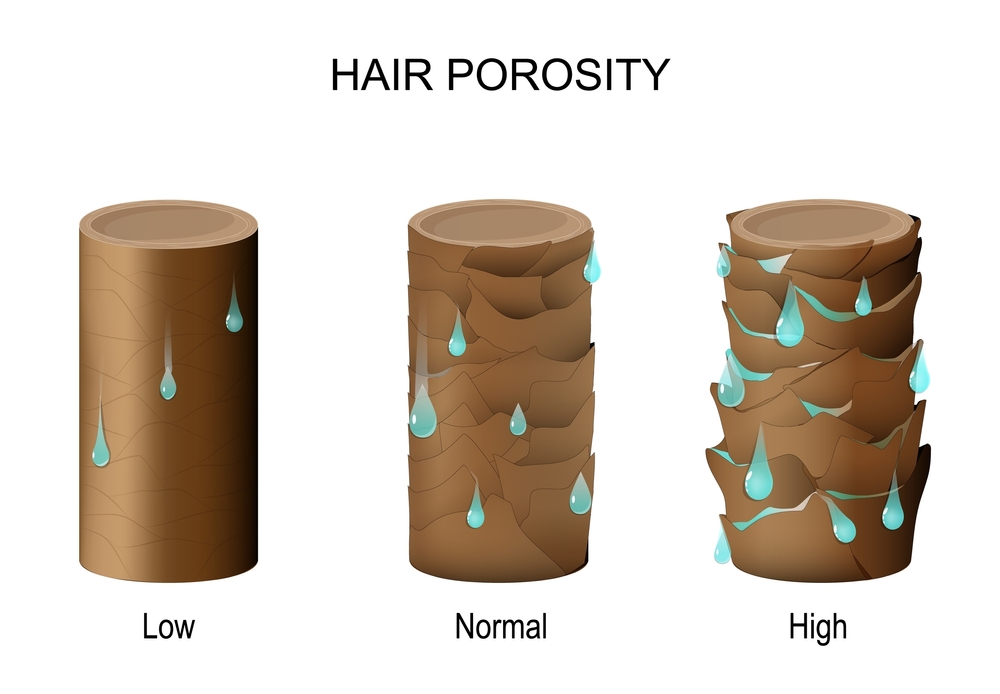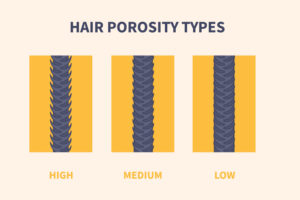As a hairstylist here at Salon D in Dallas, I often meet clients who feel frustrated: “Why does my hair stay dry no matter how much conditioner I use?” or “Why does it take forever for my hair to dry?” The secret isn’t just your hair type; it’s your hair porosity.
Hair porosity determines how well your strands absorb and retain moisture. Think of it like your hair’s sponge factor. A brand-new sponge soaks up water slowly (low porosity). A sponge full of holes lets water rush in and leak right out (high porosity). Somewhere in the middle is medium porosity, the balance most people crave.
In this guide, I’ll explain what is hair porosity?, how to test hair porosity , and how to care for your unique porosity type. Whether you’re struggling with frizz, dullness, or product buildup, this will help you finally unlock a routine that works for your hair.
What Is Hair Porosity?
It is the hair’s ability to absorb and retain moisture, oils, and products. It depends on how open or closed the cuticle layer of your hair shaft is. People generally have low porosity hair (cuticles tightly packed, moisture-resistant), medium porosity hair (balanced absorption and retention), or high porosity hair (raised cuticles that absorb moisture quickly but lose it just as fast). Understanding your hair porosity type helps determine the best hair care routine, products, and treatments for healthy, hydrated strands.
Hair Porosity Types
Low Porosity Hair: Picture a shielded surface that keeps almost everything out. With low porosity hair, the cuticle layer is tightly packed, making it tough for water, oils, and color to sink in. This often causes product buildup and makes the hair feel heavy or difficult to style. To keep it healthy, low porosity strands benefit from gentle heat during treatments and lightweight, water-based products that can slip past the barrier.
Medium Porosity Hair: This type strikes the perfect middle ground. The cuticle allows just enough moisture in and holds onto it, keeping hair soft, shiny, and easy to manage. Color tends to last longer, and styling usually requires less effort. Medium porosity is considered the most balanced and low-maintenance of all hair types.
High Porosity Hair: Here, the cuticle is more open, which means hair eagerly drinks up moisture, but struggles to keep it in. This often shows up as dryness, frizz, split ends, and faster color fading. High porosity hair thrives on nourishing masks, sealing oils, and protective styles that help lock hydration where it belongs.
What Affects Hair Porosity?
The porosity isn’t only determined by genetics; it can also be influenced by age and the way you care for your hair. While every strand has some level of porosity, damaged hair tends to be more porous. Over time, frequent heat styling, harsh chemical processes like bleaching or relaxing, and even daily UV exposure can weaken the cuticle layer, making it harder for hair to retain moisture. Lifestyle habits play a big role too, consistent use of hot tools or chemical treatments can accelerate porosity changes.
The good news? You can help protect your strands. Limit excessive heat and chemical services, and when you’re outdoors, shield your hair with UV-protective hair products, a wide-brimmed hat, or a light scarf. These small adjustments can preserve your hair’s health, slow down porosity damage, and keep your texture looking strong and vibrant.
What Is Low Porosity Hair?
This type of hair has tightly closed cuticles, almost like shingles on a roof sealed shut.
- What does low porosity hair look like? Often shiny, smooth to the touch, but it can feel product-heavy because formulas sit on top instead of penetrating.
- Does low porosity hair dry fast? No, it usually dries slowly because water clings to the surface instead of soaking in.
- Is low porosity hair good or bad? Neither. It’s just a natural characteristic. The challenge is moisture resistance; the benefit is natural shine and less frizz when treated correctly.
How Can I Care for Low Porosity Hair?
Below are some tips to follow:
- Choose Lightweight, Water-Based Products – Stick to liquid leave-ins, hydrating sprays, and lightweight oils that can penetrate instead of sitting on top. Heavy butters and thick creams often cause buildup.
- Clarify Regularly – Low porosity hair is prone to product buildup since the cuticle doesn’t easily absorb moisture. Use a clarifying shampoo or apple cider vinegar rinse once or twice a month.
- Use Heat or Steam for Conditioning – Gentle heat, like a steamer or warm towel, helps lift the cuticle so conditioners and masks can sink in effectively.
- Be Careful with Protein – Does low porosity hair need protein? Only in small amounts. Too much protein can make it feel hard, dry, or brittle.
- Deep Condition Consistently – Opt for moisture-rich deep conditioners with humectants (like glycerin, aloe, or honey) to keep hair soft and manageable.
- Avoid Heavy Layering – Keep your routine simple. Layering too many products can cause the hair to feel greasy, waxy, or weighed down.
Best Oils for Low Porosity Hair
When choosing oils for this type of hair, the key is lightweight and easily absorbable oils. Heavy oils often sit on top of the hair shaft instead of penetrating, leading to buildup.
- Is coconut oil good for low porosity hair?
Not the best choice. Coconut oil is heavy and tends to coat the strands, making it difficult for moisture to get in. This can leave hair feeling greasy and weighed down. - Is argan oil good for low porosity hair?
Yes! Argan oil is lightweight, rich in vitamins, and easily absorbed. It’s excellent for adding shine and softness without clogging the hair cuticle. - Is castor oil good for low porosity hair?
Use sparingly. Castor oil is thick and heavy, making it better for sealing the ends rather than applying all over. It can help protect against split ends if used in moderation.
Other great oils for low porosity hair include grapeseed oil, jojoba oil, and sweet almond oil, since they’re light, non-greasy, and help lock in moisture without buildup.
What Is High Porosity Hair?
High porosity hair has raised or damaged cuticles. This makes it like a leaky bucket, water goes in fast but escapes quickly.
- What causes high porosity hair? Genetics, heat damage, bleaching, chemical treatments, or environmental stress.
- Common signs: Frizz, tangles, dryness, breakage, and very quick drying time.
- Is my hair high or low porosity? If your hair soaks up products instantly but still feels dry, it’s likely high porosity.
How to Fix My High Porosity Hair?
High porosity hair has gaps and raised cuticles that cause moisture to escape quickly. To repair and manage it effectively, focus on strengthening, sealing, and protecting:
- Protein Treatments
Protein helps fill in the weak spots and gaps in the hair cuticle, making strands stronger and less prone to breakage. - Moisture Layering (LOC Method)
Apply a Leave-in conditioner, followed by Oil, and then a Cream to lock in hydration. This method seals moisture inside and prevents frizz. - Keratin Treatments
Professional keratin treatments can smooth raised cuticles, reduce tangles, and enhance manageability, though results are temporary.
For best results, combine protein care with regular deep conditioning and protective hairstyles to minimize damage.
Medium Porosity Hair: The “Balanced” Type
Medium porosity hair sits in the middle. It absorbs and retains moisture well, responds to most products, and generally looks shiny and healthy.If you have medium porosity hair, keep it balanced with occasional deep conditioning and avoid over-processing to maintain its natural state.
How to Test Hair Porosity?
Wondering how to check hair porosity at home? There are a few easy methods you can try:
1. Float Test (Water Glass Method)
This hair porosity test with the water glass method is the most popular and quick way to determine your hair type. Take a clean strand of hair and place it in a glass of water.
- If it floats, you likely have low porosity hair.
- If it sinks quickly, your hair is high porosity.
- If it stays in the middle, that means medium porosity hair.
2. Spray Test
Spray a little water onto a small section of your hair.
- If water beads up and sits on top, it indicates low porosity hair.
- If your hair soaks it in almost instantly, that’s a sign of high porosity hair.
3. Touch Test
Gently run your fingers along a strand of hair.
- If it feels smooth, you likely have low porosity.
- If it feels rough or bumpy, you may have high porosity.
How to Fix and Care for Your Hair Based on Porosity?
Fixing Low Porosity Hair
- Use clarifying shampoos to remove buildup.
- Apply deep conditioners with heat for penetration.
- Lightweight leave-ins work best.
Fixing High Porosity Hair
- Weekly protein treatments for strength.
- Seal moisture with rich oils and creams.
- Salon services like keratin treatments can smooth raised cuticles.
- Natural remedies for high porosity hair: aloe vera, yogurt masks, and avocado oil can help seal and protect.
Get Professional Help for Your Hair in Dallas
At Salon D, we provide expert, personalized solutions for every hair porosity type. Our stylists begin with a professional hair porosity test and analysis to determine whether your hair is low, medium, or high porosity. From there, we customize treatments such as deep conditioning for low porosity hair, which gently opens the cuticle to allow moisture in, or keratin treatments for high porosity hair, which smooth and strengthen damaged strands while reducing frizz and breakage. We also provide tailored hair porosity product recommendations, including the best shampoos, conditioners, leave-ins, and oils to suit your unique porosity needs. When you book a hair treatment in Dallas at Salon D, you’re not just investing in products; you’re gaining the benefit of a stylist’s trained eye, science-backed solutions, and years of hands-on experience dedicated to helping your hair look and feel its absolute best.
Conclusion:
Understanding hair porosity types, whether low, medium, or high, unlocks the secret to smoother styling, healthier growth, and products that work for you . At Salon D Dallas, we specialize in personalized porosity care. From professional hair porosity tests to customized deep conditioning and keratin treatments, our team helps you achieve the healthiest version of your hair. Ready to finally stop guessing and start thriving? Book your hair porosity analysis today at Salon D, Dallas. and discover your perfect hair care match.




